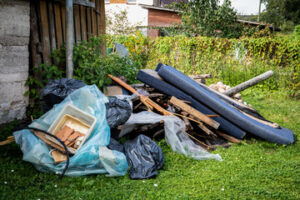Junk removal is the business of hauling trash away. Trash is not all the same, and junk removers have to make sure they separate items for disposal from those that can be reused.

Today’s consumers are more environmentally conscious than ever and want to support planet-friendly businesses. That means that companies prioritizing recycling and donating their items will do better in the marketplace. Contact Sgt Junk-It for professional help.
Junk removal is the process of removing unwanted items from your home or office. These items can be anything from old furniture to broken electronics. The cost of junk removal varies depending on the volume and type of debris. It is also important to consider the costs of labor and disposal.
A typical junk removal service charges per item. This method of pricing allows the company to estimate the number of items that will need to be hauled away and determine the total price. This method is a good choice for businesses that want to avoid surprises and make sure they are charging a fair price. However, this method can be difficult to implement for small business owners. It is important to keep an eye on your competitors and use a template to create estimates.
Junk Removal Prices vary greatly by region. Large cities often have higher rates than rural areas. Some junk removal companies may offer online pricing estimators, but others require an on-site inspection to provide a quote. It is important to understand the factors that influence junk removal prices to ensure your business is competitive and profitable.
The most significant factor affecting Junk Removal prices is the volume of waste. A larger volume requires more time and labor to remove, which drives up the cost of the service. Additionally, the volume of waste impacts the disposal and recycling fees, which also increase the overall cost.
Whether or not the trash is recycled depends on what it is made of. Plastic, paper, metals, and other materials can be sorted and recycled. This helps reduce the amount of waste sent to landfills. Many Junk Removal services are focused on being environmentally friendly. They will donate or recycle usable items and try to prevent them from going to the trash. This can add to the overall expense of the service, but it can be a good way to minimize landfill use and give back to the community.
Another major consideration when determining the cost of Junk Removal is the location of the debris. Some locations have higher traffic or are more prone to accidents, which can lead to increased labor and fuel expenses. Other considerations include the cost of equipment and tools, insurance, and permits. Some Junk Removal services may need specialized equipment and tools to complete certain tasks. This can lead to higher costs, but it is necessary for a safe and efficient operation.
Cost Per Load
Junk removal is a service that is highly in demand. This means that there are a lot of companies competing for this business. As a result, the price of junk removal services can vary significantly. It is important to understand what factors influence junk removal pricing to ensure that your company offers competitive prices and maintains a profit margin. One important factor is determining the volume of junk that needs to be removed. This will help you determine how much to charge per load. The volume of junk will also impact disposal fees and recycling costs. In addition, it will determine the type of equipment and manpower required to remove the waste.
Junk removal companies offer a variety of services to cater to different customer needs. Some specialize in residential junk removal while others may target commercial clients or construction sites. Each group has unique demands and requirements, which will affect the cost of junk removal services. For example, it is often more expensive to haul away heavy items than light ones. In addition, some types of junk require specialized handling and safety measures, which can lead to higher costs.
Most junk removal companies use an estimate template to determine how much to charge for their services. This allows them to take into account all of the necessary expenses and make sure they are covering their labor, fuel, and equipment costs. The most common type of pricing is a cost-plus approach, which takes into account direct and indirect costs. This method of pricing is more effective than simply estimating how much a job will cost.
Once a client has agreed to hire a junk removal company, the specialist will visit the location and inspect the junk. He or she will then provide the client with a quote. Some junk removal services will take pictures or video of the junk pile so that the professional can get a good idea of how much it will cost to remove it.
Once the junk is sorted, the junk removal company will recycle or donate usable items. They will also dispose of any items that can’t be reused. Some junk removal companies have several truck sizes, which can accommodate varying sized loads. This can save you money if you have a large amount of junk to remove.
Cost Per Hour
Junk removal is an essential service for homeowners, but it’s not always easy to get accurate estimates. Many junk removal services don’t offer online quotes, and the pricing models vary widely between local and national companies. Some charge flat rates for a specific number of hours, while others use a hybrid model combining a flat fee and hourly rate. It’s important to ask about these details before deciding on a company.
Junk haulers charge different rates based on the volume of trash they collect, the weight of the items, and the amount of labor needed to dispose of them. This allows them to make a profit while keeping prices affordable for customers. To avoid any misunderstandings, junk removal services should clearly communicate their pricing structure and provide a written estimate of the total cost. This will help prevent misunderstandings between customers and contractors, as well as save the company money on credit card transaction fees.
The location of the junk pile also plays a role in pricing. Some areas require permits and have special requirements for disposing of junk, which can add to the overall cost. Additionally, some areas have narrow roads that are difficult for large trucks to navigate. In addition, some cities have higher rates for waste disposal, which can increase the price of Junk Removal.
Labor costs are another major factor in Junk Removal pricing. This is because most junk haulers are a service-based business, and their costs fluctuate based on the demand in their area. Additionally, labor rates vary by region, and businesses must take into account factors like the cost of living in their area.
Lastly, junk removal services must also consider other operational expenses, such as fuel and transport costs. The amount of trash collected also affects these costs, as does the distance between the pickup and drop-off locations. Additionally, it’s important to calculate overhead costs, including payroll taxes, and include them in the Junk Removal price. These costs can add up quickly and lead to unexpected costs for the customer, which can be frustrating. However, with careful planning and the right mindset, these costs can be minimized.
Cost Per Mile
When it comes to Junk Removal, there are a lot of factors that can affect the price. The first factor is the amount of junk that you have. Large items like furniture, appliances and electronics are more expensive to remove than smaller items such as toys and clothing. The second factor is the location of your junk. If it is in a remote location, it will cost more to remove than if it was near your house. This is because the truck needs to travel farther to dispose of the junk.
A third factor is the type of junk that you have. Some types of junk require special processing or disposal, which adds to the cost. For example, electronic waste (e-waste) must be processed and shredded before it can be recycled. This is because it contains toxic materials, such as lead and mercury. Some junk removal companies also offer recycling services. They will collect your old electronics and take them to a local recycler for processing.
Some junk removal companies charge a flat fee to remove junk from your property. Others charge a per-item rate. For these services, the company will send a team to your home or office to assess the amount of junk you have and estimate how much it will cost to remove. Some companies even provide a free quote on their website, so you can compare prices before hiring.
Another option is to rent a dumpster from a junk removal service. This is ideal for large cleanups and renovation projects. The junk removal company will drop off a dumpster in your preferred size at your site, and you can fill it up as you go. Once the dumpster is full, the junk removal company will haul it away. This option is usually cheaper than paying for a full-service junk removal.
A final factor that can influence the price of Junk Removal is whether or not you are going to use a truck-load pricing model. Most junk removal services use this model, which means that they will charge you based on how much space your junk takes up in the truck. This is a good way to make sure that you don’t overpay for the junk removal services.
